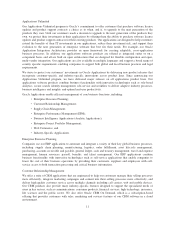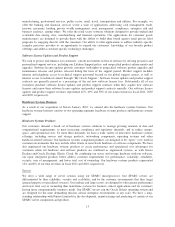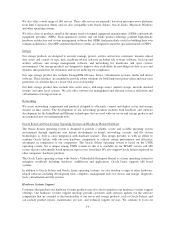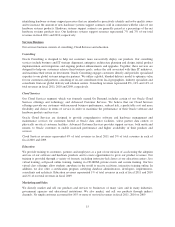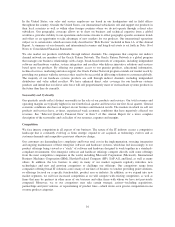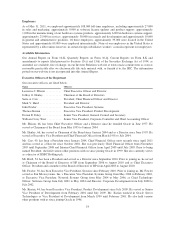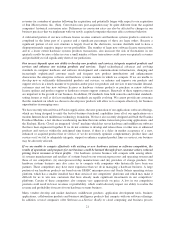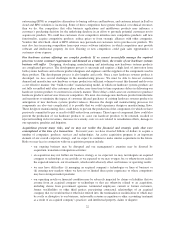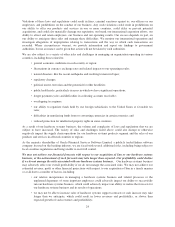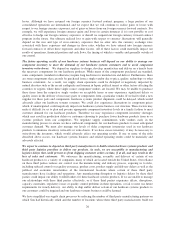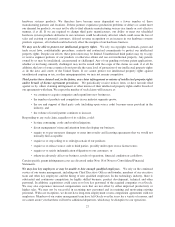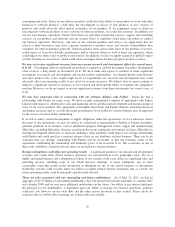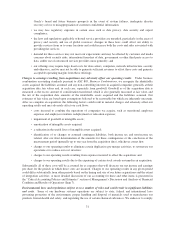Oracle 2011 Annual Report Download - page 23
Download and view the complete annual report
Please find page 23 of the 2011 Oracle annual report below. You can navigate through the pages in the report by either clicking on the pages listed below, or by using the keyword search tool below to find specific information within the annual report.revenues for a number of quarters following the acquisition, and potentially longer with respect to our acquisition
of Sun Microsystems, Inc. (Sun). Conversion rates post-acquisition may be quite different from the acquired
companies’ historical conversion rates. Differences in conversion rates can also be affected by changes in our
business practices that we implement with our newly acquired companies that may affect customer behavior.
A substantial portion of our new software license revenue contracts and hardware systems products contracts is
completed in the latter part of a quarter and a significant percentage of these are large orders. Because a
significant portion of our cost structure is largely fixed in the short-term, revenue shortfalls tend to have a
disproportionately negative impact on our profitability. The number of large new software license transactions,
and to a lesser extent hardware systems products transactions, also increases the risk of fluctuations in our
quarterly results because a delay in even a small number of these transactions could cause our quarterly revenues
and profitability to fall significantly short of our predictions.
Our success depends upon our ability to develop new products and services, integrate acquired products and
services and enhance our existing products and services. Rapid technological advances and evolving
standards in computer hardware and software development and communications infrastructure, changing and
increasingly sophisticated customer needs and frequent new product introductions and enhancements
characterize the enterprise software and hardware systems markets in which we compete. If we are unable to
develop new or sufficiently differentiated products and services, or enhance and improve our products and
support services in a timely manner or to position and/or price our products and services to meet market demand,
customers may not buy new software licenses or hardware systems products or purchase or renew software
license updates and product support or hardware systems support contracts. Renewals of these support contracts
are important to the growth of our business. In addition, IT standards from both consortia and formal standards-
setting forums as well as de facto marketplace standards are rapidly evolving. We cannot provide any assurance
that the standards on which we choose to develop new products will allow us to compete effectively for business
opportunities in emerging areas.
We have recently released Oracle Fusion Applications, the next generation of our applications software offerings,
which are being designed to unify the best-of-business functional capabilities from all of our applications on a
modern Internet-based middleware technology foundation. We have also recently designed and built the Exadata
Database Machine, a fast database warehousing machine that runs online transaction processing applications, and
the Exalogic Elastic Cloud, an integrated “cloud” machine which has server hardware and middleware software
that have been engineered together. If we do not continue to develop and release these or other new or enhanced
products and services within the anticipated time frames, if there is a delay in market acceptance of a new,
enhanced or acquired product line or service, if we do not timely optimize complementary product lines and
services or if we fail to adequately integrate, support or enhance acquired product lines or services, our business
may be adversely affected.
If we are unable to compete effectively with existing or new hardware systems or software competitors, the
results of operations and prospects for our business could be harmed through fewer customer orders, reduced
pricing, lower revenues or lower profits. Our hardware systems business will compete with, among others,
(i) systems manufacturers and resellers of systems based on our own microprocessors and operating systems and
those of our competitors, (ii) microprocessor/chip manufacturers and (iii) providers of storage products. Our
hardware systems business may also cause us to compete with companies who historically have been our
partners. These competitors may have more experience than we do in managing a hardware business. A large
portion of our hardware products are based on our SPARC microprocessor and Oracle Solaris operating system
platform, which has a smaller installed base than certain of our competitors’ platforms and which may make it
difficult for us to win new customers that have already made significant investments in our competitors’
platforms. Certain of these competitors also compete very aggressively on price. A loss in our competitive
position could result in lower revenues or profitability, which could adversely impact our ability to realize the
revenue and profitability forecasts for our hardware systems business.
Many vendors develop and market databases, middleware products, application development tools, business
applications, collaboration products and business intelligence products that compete with our software offerings.
In addition, several companies offer Software-as-a-Service (SaaS) or cloud computing and business process
21


